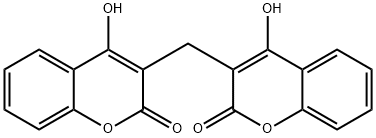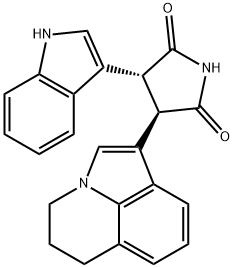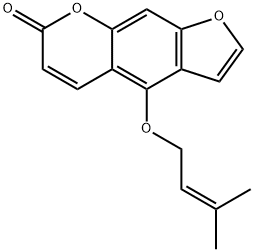A7091858
Dicoumarol , 10mMinDMSO , 66-76-2
Synonym(s):
3,3ʹ-Methylenebis(4-hydroxycoumarin), Bishydroxycoumarin, Dicumarol;Bishydroxycoumarin;Dicoumarol;Dicoumarol - CAS 66-76-2 - Calbiochem;Dicumarol
CAS NO.:66-76-2
Empirical Formula: C19H12O6
Molecular Weight: 336.3
MDL number: MFCD00006857
EINECS: 200-632-9
| Pack Size | Price | Stock | Quantity |
| 1ml | RMB559.20 | In Stock |
|
| others | Enquire |
Update time: 2022-07-08
PRODUCT Properties
| Melting point: | 290-292 °C(lit.) |
| Boiling point: | 392.79°C (rough estimate) |
| Density | 1.2864 (rough estimate) |
| refractive index | 1.4450 (estimate) |
| storage temp. | Sealed in dry,Room Temperature |
| solubility | DMSO:3.06(Max Conc. mg/mL);9.1(Max Conc. mM) DMSO:PBS (pH 7.2) (1:1):0.5(Max Conc. mg/mL);1.49(Max Conc. mM) DMF:1.25(Max Conc. mg/mL);3.72(Max Conc. mM) Water:50.0(Max Conc. mg/mL);148.68(Max Conc. mM) |
| pka | 4.20±1.00(Predicted) |
| form | Fine Crystalline Powder |
| color | White |
| biological source | synthetic (organic) |
| Water Solubility | Soluble in aqueous alkaline solutions, organic bases, 0.1 N NaOH (15 mg/ml), Pyridine (50 mg/ml), chloroform (slightly soluble), and benzene (slightly soluble). Insoluble in water, and alcohols. |
| Merck | 14,3090 |
| EPA Substance Registry System | 2H-1-Benzopyran-2-one, 3,3'-methylenebis[4-hydroxy- (66-76-2) |
Description and Uses
The plants containing dicoumarol mainly include red carnation grass (Trifolium pratense L., hongchezhoucao), rotten alfalfa (Medicago sativa L., zimuxu), rotten white vanilla rhinoceros (Melilotus albus Desr., baixiangcaomuxi), and other plants in Leguminosae.
This drug is used for preventing and treating thrombosis, thrombophlebitis, thromboemolium, and for preventing thrombo-formation in post-operational periods.
Safety
| Symbol(GHS) |    GHS06,GHS08,GHS09 |
| Signal word | Danger |
| Hazard statements | H301-H372-H411 |
| Precautionary statements | P260-P264-P270-P273-P301+P310-P314 |
| Hazard Codes | T,N |
| Risk Statements | 22-48/25-51/53 |
| Safety Statements | 37-45-61 |
| RIDADR | UN 2811 6.1/PG 3 |
| WGK Germany | 3 |
| RTECS | GN7875000 |
| TSCA | Yes |
| HazardClass | 6.1(b) |
| PackingGroup | III |
| HS Code | 29322985 |
| Hazardous Substances Data | 66-76-2(Hazardous Substances Data) |
| Toxicity | LD50 orally in rats: 541.6 mg/kg (Rose) |



